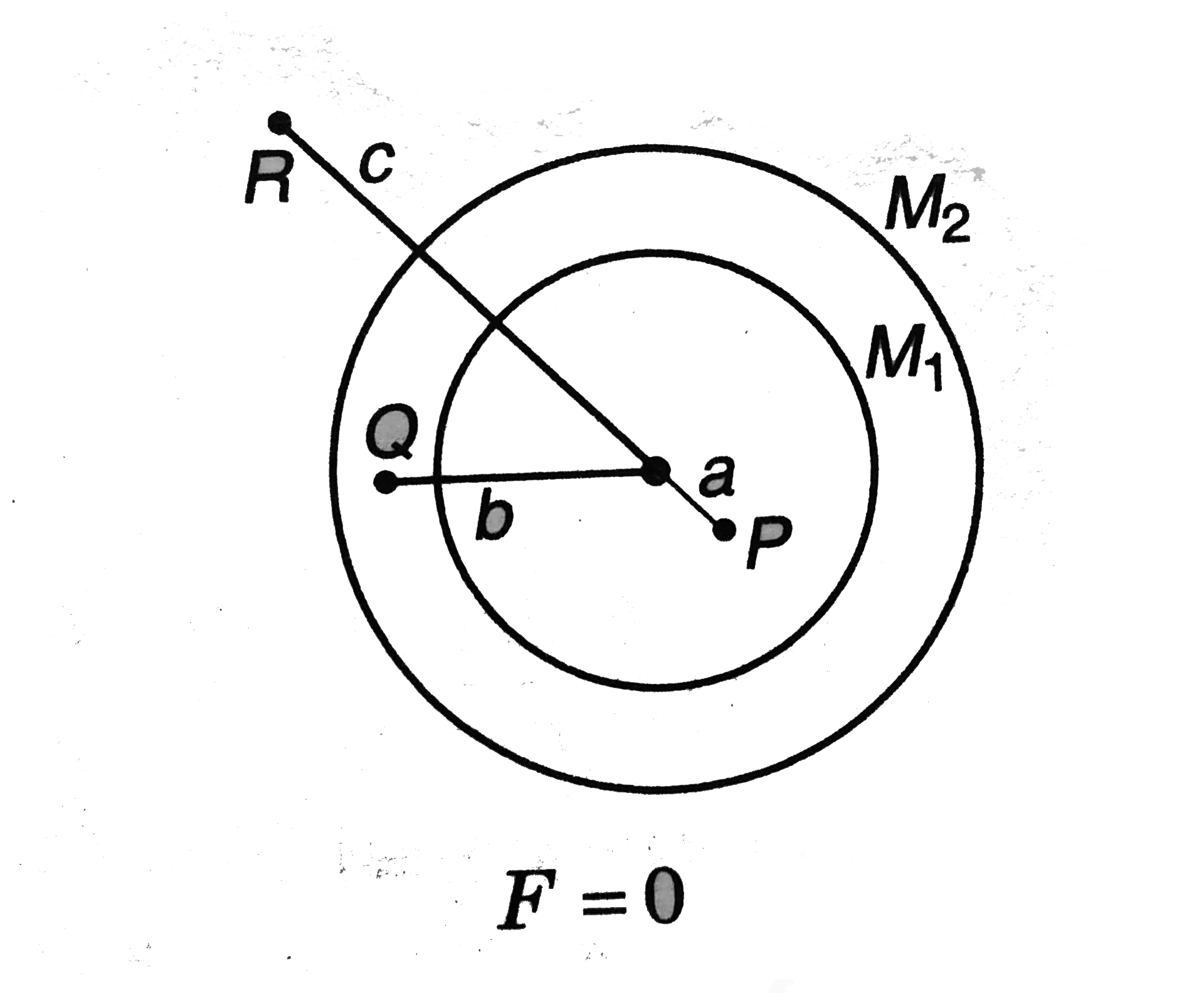Two concentric spherical shells have masses m1, m2 and radit R1,R2(R1<R2). Calculate the force by this system on a particle of mass m, if it is placed at a distance (R1+R2)2 from the centre.
The correct Answer is:A, B, D
To solve the problem, we need to calculate the gravitational force exerted by two concentric spherical shells on a particle of mass m placed at a distance R1+R22 from the center. Here are the steps to find the solution:
Step 1: Understand the Setup
We have two spherical shells:
- Inner shell with mass m1 and radius R1
- Outer shell with mass m2 and radius R2 (where R1<R2)
The particle of mass m is located at a distance r=R1+R22 from the center of the shells.
Step 2: Determine the Position of the Particle
Since R1<R2, the distance r=R1+R22 is greater than R1 but less than R2:
- This means the particle is outside the inner shell but inside the outer shell.
Step 3: Gravitational Force Inside a Shell
According to the shell theorem:
- The gravitational force inside a spherical shell is zero.
- Therefore, the gravitational force due to the outer shell (mass m2) on the particle is zero since the particle is inside the outer shell.
Step 4: Calculate the Gravitational Field Due to the Inner Shell
The gravitational field E1 due to the inner shell at the position of the particle is given by the formula:
E1=−Gm1r2
where r=R1+R22.
Step 5: Calculate the Gravitational Field at the Position of the Particle
Substituting r into the equation:
E1=−Gm1(R1+R22)2
This simplifies to:
E1=−4Gm1(R1+R2)2
Step 6: Calculate the Gravitational Force on the Particle
The gravitational force F on the particle of mass m due to the gravitational field E1 is given by:
F=m⋅E1
Substituting E1:
F=m(−4Gm1(R1+R2)2)
Thus, the force exerted on the particle is:
F=−4Gm1m(R1+R2)2
Final Answer
The force by the system on the particle is:
F=−4Gm1m(R1+R2)2
---
We have two spherical shells:
- Inner shell with mass m1 and radius R1
- Outer shell with mass m2 and radius R2 (where R1<R2)
Since R1<R2, the distance r=R1+R22 is greater than R1 but less than R2:
- This means the particle is outside the inner shell but inside the outer shell.
According to the shell theorem:
- The gravitational force inside a spherical shell is zero.
- Therefore, the gravitational force due to the outer shell (mass m2) on the particle is zero since the particle is inside the outer shell.
The gravitational field E1 due to the inner shell at the position of the particle is given by the formula:
E1=−Gm1r2
where r=R1+R22.
Substituting r into the equation:
E1=−Gm1(R1+R22)2
This simplifies to:
E1=−4Gm1(R1+R2)2
The gravitational force F on the particle of mass m due to the gravitational field E1 is given by:
F=m⋅E1
Substituting E1:
F=m(−4Gm1(R1+R2)2)
Thus, the force exerted on the particle is:
F=−4Gm1m(R1+R2)2
The force by the system on the particle is:
F=−4Gm1m(R1+R2)2
Topper's Solved these Questions
- GRAVITATIONBOOK - DC PANDEY ENGLISHCHAPTER - GRAVITATIONEXERCISE - Level 2 Single Correct
22 Videos
- GRAVITATIONBOOK - DC PANDEY ENGLISHCHAPTER - GRAVITATIONEXERCISE - Level 2 More Than One Correct
10 Videos
- GRAVITATIONBOOK - DC PANDEY ENGLISHCHAPTER - GRAVITATIONEXERCISE - Level 1 Single Correct
27 Videos
- GENERAL PHYSICSBOOK - DC PANDEY ENGLISHCHAPTER - GENERAL PHYSICSEXERCISE - INTEGER_TYPE
2 Videos
- KINEMATICSBOOK - DC PANDEY ENGLISHCHAPTER - KINEMATICSEXERCISE - INTEGER_TYPE
10 Videos
Similar Questions
Two concentric spherical shells have masses m1andm2 and radii r1andr2(r2>r1). What is the force exerted by this system on a particle of mass m3. If it is placed at a distance r(r1<r<r2) from the centre ?
View SolutionTwo concentric spherical shells have masses M1,M2 and radii R1,R2(R1<R2). What is the force exerted by this system on a particle of mass m if it is placed at a distance R1+R22 from the center?
View SolutionThe capacitance of two concentric spherical shells of radii R1 and R2(R2>R1) is
View SolutionTwo concentric spherical shells of masses and radii m1,r1andm2,r2 respectively are as shown. The gravitational field intensity at point P is

View SolutionTwo concentric shells of masses M1 and M2 are having radii r1 and r2. Which of the following is the correct expression for the gravitational field on a mass m?

View SolutionTwo concentric shells of masses M1 and M2 are having radii r1 and r2. Which of the following is the correct expression for the gravitational field on a mass m?

View SolutionTwo concentric spherical shells of radius R1 and R2(R2>R1) are having uniformly distributed charges Q1 and Q2 respectively. Find out total energy of the system.

View SolutionTwo concentric shells of masses M1 and M2 are concentric as shown. Calculate the gravitational force on m due to M1 at points P,Q and R.

View SolutionTwo concentric shells of masses M1 and M2 are having radii r1 and r2. Which of the following is the correct expression for the gravitational field at a distance r ?
View SolutionA sphare of mass M and radiusR2 has a concentric cavity of radius R1 as shown in figure The force F exerted by the sphere on a particle of mass m located at a distance r from the centre of sphere veries as (0≤r≤∞) .

View Solution

